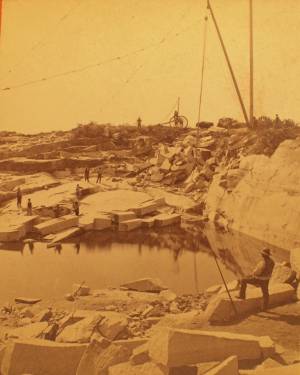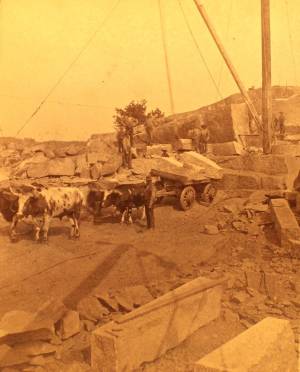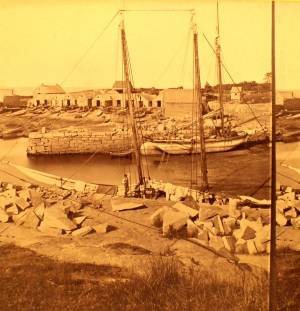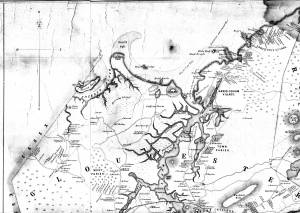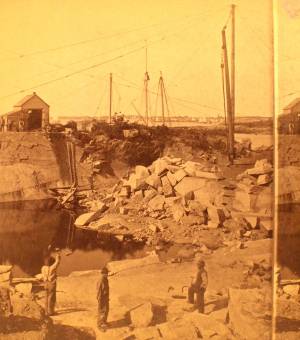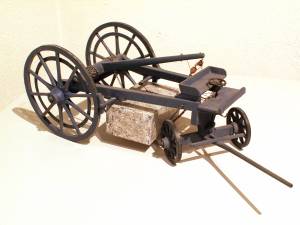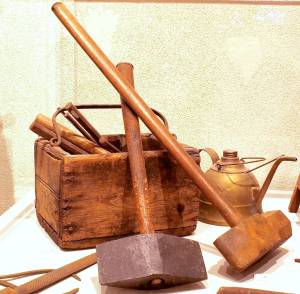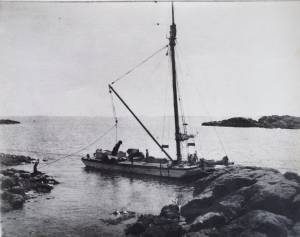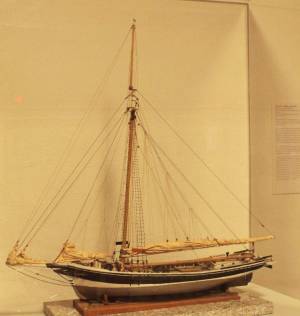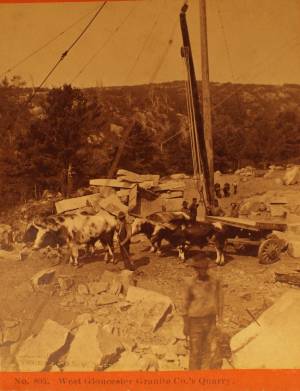An online project under the direction of the CAPE ANN MUSEUM
Historical Materials: Maritime & Other Industries & Facilities
Historical Materials » Maritime & Other Industries & Facilities » Granite Quarrying / Shipping
Granite Quarrying / Shipping
View related Fitz Henry Lane catalog entries (7) »
The harvesting of granite from quarries dug deep into the earth was an important industry on Cape Ann from the 1830s through the early 20th century. Second only to fishing in economic output, for 100 years the granite business played a pivotal role in the local economy providing jobs for many, turning profits for some and generating tons and tons of cut granite that was used here on Cape Ann and shipped to ports all along the Atlantic seaboard.
Granite quarrying started slowly in this area in the late eighteenth century with small operations peppered across the rocky terrain. Construction of a fort at Castle Island in Boston Harbor in 1798 followed by a jail in nearby Salem in 1813, jump-started the granite industry here on Cape Ann. During the 1830s and 1840s, the trade grew steadily. By the 1850s, the stone business was firmly established and Cape Ann granite was known throughout the region. So extensive and so awe-inspiring were operations during the second half of the nineteenth century some observers feared that the business might actually run out of stone.
While granite was taken from the earth in all different sizes and shapes, Cape Ann specialized in the conversion of that granite into paving blocks which were used to finish roads and streets. Millions of paving stones were shipped out of Cape Ann annually, destined for construction projects in New York, Philadelphia and all along the Atlantic seaboard. While paving blocks were basically uniform in size, there were subtle differences leading some to be referred to as Philadelphia blocks while others were identified as Boston blocks or Washington blocks.
– Martha Oaks (April, 2015)
Related tables: Cut, The (Stacy Blvd.) » // Fresh Water Cove » // Sloop »
Stereograph card
Cape Ann Museum Library & Archive
This view shows a wood derrick for hoisting granite blocks.
Also filed under: Eastern Point » // Historic Photographs »
Stereograph
Cape Ann Museum Library & Archive
Also filed under: Historic Photographs »
Stereograph
Cape Ann Museum Library & Archive
Also filed under: Gundalow / Scow »
44 x 34 in.
Henry Francis Walling, Map of the Towns of Gloucester and Rockport, Essex Co. Massachusetts. Philadelphia, A. Kollner, 1851
Cape Ann Museum Library & Archive
"Map of the Towns of Gloucester and Rockport, Massachusetts. H.F. Walling, Civil Engineer. John Hanson, Publisher. 1851. Population of Gloucester in 1850 7,805. Population of Rockport in 1850 3,213."
View related Fitz Henry Lane catalog entries (1) »
Also filed under: Annisquam River » // Babson House » // Coffin's Beach » // Eastern Railroad » // Gloucester, Mass. – Annisquam Harbor Lighthouse » // Loaf, The » // Low (David) House » // Maps » // Old First Parish / Subsequent Fourth Parish Church (at the Green) » // Riverdale Methodist Church (Washington Street) » // White-Ellery House »
Stereograph card
Cape Ann Museum Library & Archive
This view shows a wood derrick for hoisting granite blocks.
Also filed under: Eastern Point » // Historic Photographs »
Painted wood
Scale: 1:16. Galamander shop, Vinalhaven, Maine.
Cape Ann Museum. Gift of Barbara Erkkila, 1997
In the nineteenth century granite was hauled from Cape Ann quarries on heavy carts called garymanders which were pulled by oxen or horses (known as "galamander" in Maine.) A boom rigged above the rear axle was used to hoist the stone so it could be held by chains beneath the wagon. The garymander oak wheels were eight feet high with iron rims made by a blacksmith.
Also filed under: Objects »
Cape Ann Museum (1994.65)
Oilcan originally owned by Frederickj "Rick" Larsen
Cape Ann Museum (1994.76.3)
Peen hammer originally owned by Johann Jacob Erkkila (1877–1939)
(Cape Ann Museum) 1994.76.23a
Heavy blacksmith's sledge owned by John Fuge (1873–1967)
Cape Ann Museum (1997.24.0)
Although from a later period, these tools are similar to tools used in Lane's time.
Also filed under: Objects »
Photograph
Private collection
Granite scow being unloaded at Knowlton's Point, Sandy Bay. Sandy Bay Ledge visible in right background, Dodge's Rock in left background.
Also filed under: Gundalow / Scow »
Wood, metal, cordage, cloth, paint.
Scale: ¼ in. = 1ft. (1:48)
Cape Ann Museum. Gift of Roland and Martta Blanchet (1997.17.3)
Although built in 1890 and larger than the stone sloops of Lane’s time, the "Albert Baldwin’s" hull form, rig, and loading boom are very similar to those of the 1840s and 1850s.
Also filed under: Ship Models » // Sloop »
Stereograph
Cape Ann Museum Library & Archive
Also filed under: Historic Photographs »
